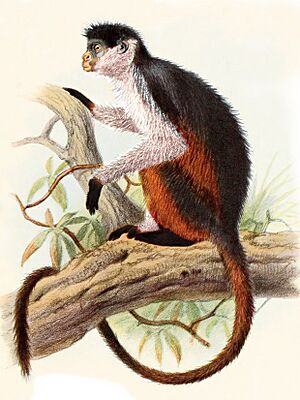Niger Delta red colobus facts for kids
Quick facts for kids Niger Delta red colobus |
|
|---|---|
 |
|
| Conservation status | |
| Scientific classification | |
| Genus: |
Piliocolobus
|
| Species: |
epieni
|
| Synonyms | |
|
|
The Niger Delta red colobus (Piliocolobus epieni) is a special type of monkey. It is found only in the western part of the Niger Delta in Nigeria. This monkey is critically endangered, meaning it is in great danger of disappearing forever. Its biggest threats are hunting and the loss of its natural home.
What Does It Look Like?
The Niger Delta red colobus has a unique look. Its back, from its head to its rump, is black. The sides of its body and its outer legs are orange-brown.
Its belly, inner legs, and most of its arms are white. Its hands and feet are black. The tail is red-brown on top and a darker maroon or chestnut color underneath. The tip of its tail gets even darker. This monkey also has white whiskers on its face.
Where Does It Live?
This rare monkey lives only in the western part of the Niger Delta. It prefers a special kind of home called a marsh forest. This is a forest where the ground is always wet, like a swamp, but it doesn't flood deeply.
Many other primates share this habitat with the Niger Delta red colobus. These include the Nigerian white-throated guenon, the red-capped mangabey, the putty-nosed monkey, and the mona monkey. Sometimes, the olive colobus might also live there.
Why Is It Endangered?
When scientists first found the Niger Delta red colobus in 1993, there were many of them. But they were already facing problems from deforestation. This means forests were being cut down, especially trees like Hallea ledermannii, which is an important food source for these monkeys.
Since then, the problems have gotten much worse. More trees are being cut down, and people are hunting these monkeys for bushmeat. Red colobus monkeys are very sensitive to hunting and changes in their habitat. This makes scientists worry that the Niger Delta red colobus could soon become extinct.
In 2008, some of these monkeys were still found in the Edumanom Forest Reserve. However, the International Union for Conservation of Nature (IUCN) now lists it as critically endangered. This is because its population has dropped by more than 80% in the last 30 years. This big drop is mainly due to hunting and the loss of its home. In 2010, the Niger Delta red colobus was even put on a list called "The World’s 25 Most Endangered Primates". This list is made by the IUCN and other groups to highlight animals most at risk.


